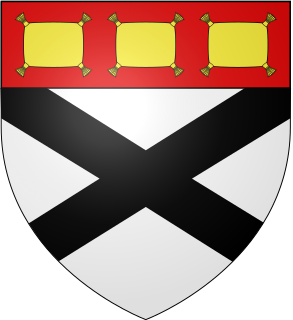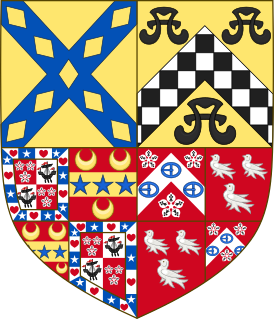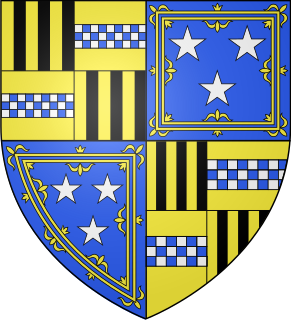
Duke of Atholl, alternatively Duke of Athole, named after Atholl in Scotland, is a title in the Peerage of Scotland held by the head of Clan Murray. It was created by Queen Anne in 1703 for John Murray, 2nd Marquess of Atholl, with a special remainder to the heir male of his father, the 1st Marquess.

Viscount Cobham is a title in the Peerage of Great Britain that was created in 1718. Owing to its special remainder, the title has passed through several families. Since 1889, it has been held by members of the Lyttelton family.

Earl of Annandale and Hartfell is a title in the Peerage of Scotland, created in 1661 for James Johnstone.

Earl of Stair is a title in the Peerage of Scotland. It was created in 1703 for the lawyer and statesman John Dalrymple, 2nd Viscount of Stair.

Earl Waldegrave is a title in the Peerage of Great Britain. It was created in 1729 for James Waldegrave, 2nd Baron Waldegrave.

Earl of Mansfield, in the County of Nottingham, and Earl of Mansfield, in the County of Middlesex, are two titles in the Peerage of Great Britain that have been united under a single holder since 1843.

Earl of Lonsdale is a title that has been created twice in British history, firstly in the Peerage of Great Britain in 1784, and then in the Peerage of the United Kingdom in 1807, both times for members of the Lowther family.

Earl Cathcart is a title in the Peerage of the United Kingdom.

Earl of Cromartie is a title that has been created twice, both for members of the Mackenzie family. It was first created as Earl of Cromarty in the Peerage of Scotland in 1703 for Sir George Mackenzie, 2nd Baronet, but his titles were forfeited after the Jacobite rising of 1745. It was recreated in 1861 in the Peerage of the United Kingdom for Anne Sutherland-Leveson-Gower, Duchess of Sutherland. Since 1979, the Earl of Cromartie has been chief of Clan Mackenzie.

David Murray, 2nd Earl of Mansfield,, known as The Viscount Stormont from 1748 to 1793, was a British politician. He succeeded to both the Mansfield and Stormont lines of the Murray family, inheriting two titles and two fortunes.
William David Mungo James Murray, 8th Earl of Mansfield, 7th Earl of Mansfield DL, JP, styled Lord Scone until 1970, was a British nobleman and Conservative politician.

John Murray, 1st Marquess of Atholl, KT was a leading Scottish royalist and defender of the Stuarts during the English Civil War of the 1640s, until after the rise to power of William and Mary in 1689. He succeeded as 2nd Earl of Atholl on his father's demise in June 1642 and as 3rd Earl of Tullibardine after the death of his first cousin the 2nd Earl in 1670.

Clan Murray is a Highland Scottish clan. The chief of the Clan Murray holds the title of Duke of Atholl. Their ancestors who established the family in Scotland in the 12th century were the Morays of Bothwell. In the 16th century descendants of the Morays of Bothwell, the Murrays of Tullibardine, secured the chiefship of the clan and were created Earls of Tullibardine in 1606. The first Earl of Tullibardine married the heiress to the Stewart earldom of Atholl and Atholl therefore became a Murray earldom in 1626. The Murray Earl of Atholl was created Marquess of Atholl in 1676 and in 1703 it became a dukedom. The marquess of Tullibardine title has continued as a subsidiary title, being bestowed on elder sons of the chief until they succeed him as Duke of Atholl.

William David Murray, 4th Earl of Mansfield, 3rd Earl of Mansfield KT DL, was a British Conservative politician.
Lord Balvaird is a title in the Peerage of Scotland. It was created in 1641 for Sir Andrew Murray, who was at that time also the feudal Lord of Balvaird. His son, the second Lord, succeeded as fourth Viscount Stormont in 1658 according to a special remainder in the letters patent. The latter's great-grandson, the seventh Viscount, succeeded his uncle as second Earl of Mansfield in 1793, also according to a special remainder in the letters patent.

David Murray, 1st Viscount of Stormont was a Scottish courtier, comptroller of Scotland and captain of the king's guard, known as Sir David Murray of Gospertie, then Lord Scone, and afterwards Viscount Stormont. He is known for his zeal in carrying out the ecclesiastical policy of James VI and I, in which he was effective if crude.
Sir Andrew Murray, 1st Lord Balvaird (1597?–1644) was a Scottish minister of Abdie in Fife, and the only minister of the Church of Scotland on whom a knighthood or peerage was conferred.
Alexander David Mungo Murray, 9th Earl of Mansfield, 8th Earl of Mansfield, styled Lord Scone until 2015, is a British nobleman.
Louisa Murray, 2nd Countess of Mansfield, formerly Louisa Cathcart, was a Scottish noblewoman, who was married twice: first to David Murray, 2nd Earl of Mansfield, and then to the Hon. Robert Fulke Greville.
John Murray, 1st Earl of Annandale was a Scottish courtier and Member of Parliament.










